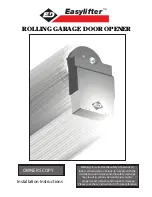
11
WIRING A KEYPAD OR TELEPHONE ENTRY
SYSTEM
Install according to the manufacturer's instructions. Follow Figure 14
for connections to the LP1000 17 position terminal strip.
BI-PARTING APPLICATION
In a bi-parting application, two operators are required, one operating
in a left-hand mode, the other in a right-hand mode. Both must be
wired for AC power (as previously described) but share a common
set of input controls. In general, all of the preceding instructions
concerning installation of individual operators can be followed in a
bi-parting application except the following:
Choose one of the operators to be the PRIMARY and the other to be
the SECONDARY. Route all of the control wiring to the PRIMARY
operator first. This will prevent grounding loop problems which can
occur when more than one COMMON or ground wire is attached
between separate operators. All accessory equipment should also be
wired to the PRIMARY.
Connect terminal #14 (MASTER OPEN) on the PRIMARY operator
to terminal #6 (OPEN) on the SECONDARY operator. Connect
terminal #15 (MASTER CLOSE) on the PRIMARY operator to
terminal #7 (CLOSE) on the SECONDARY operator. Connect
terminal #16 (COMMON) on the PRIMARY operator to terminal
#16 (COMMON) on the SECONDARY operator . Dual 1/4"
disconnect terminals for each input are provided for this purpose.
Use conduit SEPARATE from AC power service. See Figure 15 for
the correct wiring.
WIRING A RADIO RECEIVER
Radio receivers must be of the 4-wire connection hook-up type (where
the power input for the receiver is separate from the receiver’s output
connection). This is necessary as the LP1000 control board 24 VAC is
isolated from chassis ground. A 3-prong receiver
CANNOT
be
installed in association with the LP1000 control board.
Connect the receiver’s two wires for power to terminals #1 and 2 (24
VAC). The radio receiver installation is now complete. Connect one
of the two wires for the relay to terminal #4 (RADIO OPEN) or
terminal #3 (ALTERNATE) depending on the function desired (see
descriptions on the chart on page 17 and 18) and the other wire to
terminal #16 (COMMON) on the LP1000 terminal strip. See Figure 12
for connecting a four wire radio receiver.
WIRING A 3-BUTTON STATION
See Figure 13 for instructions on wiring a 3-button station.
NOTE:
The STOP button is normally OPEN
16
8
7
6
COMMON
STOP
CLOSE
OPEN
OPEN
CLOSE
STOP
WIRING 3-BUTTON STATION
WITH NORMALLY OPEN STOP
TERMINAL
STRIP
Figure 13: Wiring 3 Button
Station
110121
C
: INSTALLING THE OPERATOR
16
4
2
1
COMMON
RADIO OPEN
24 VAC
24 VAC
WIRING FOUR-WIRE RECEIVER
TERMINAL
STRIP
ALTERNATE
3
FREE EXIT
5
OPEN
6
DRY CONTACT
RELAY OUTPUT
24VAC POWER
FOR RECEIVER
Figure 12: Wiring 4-Wire Receiver
110120
CONNECT TO:
OR:
WARNING!
RISK OF ENTRAPMENT!
TO REDUCE THE RISK OF INJURY OR DEATH:
LOCATE KEYPAD, CARD READER, KEY
SWITCH OR SIMILAR ENTRY DEVICES IN A
LOCATION WHERE A USER CAN NOT REACH
THROUGH THE GATE OR FENCE TO ACTIVATE
THE GATE OPERATOR. THE RECOMMENDED
DISTANCE BETWEEN THE GATE OR FENCE
AND ACCESSORY SWITCH IS 10 FEET.
16
6
2
1
COMMON
OPEN
24 VAC
24 VAC
WIRING PHONE ENTRY SYSTEM
NOTE: A DEDICATED POWER SUPPLY
TERMINAL
STRIP
1
2
3
4
5
6
7
8
9
*
0
#
IS REQUIRED FOR THE ENTRY SYSTEM
NORMALLY OPEN
DRY CONTACTS
FREE EXIT
5
Figure 14: Wiring an Access System
110122










































